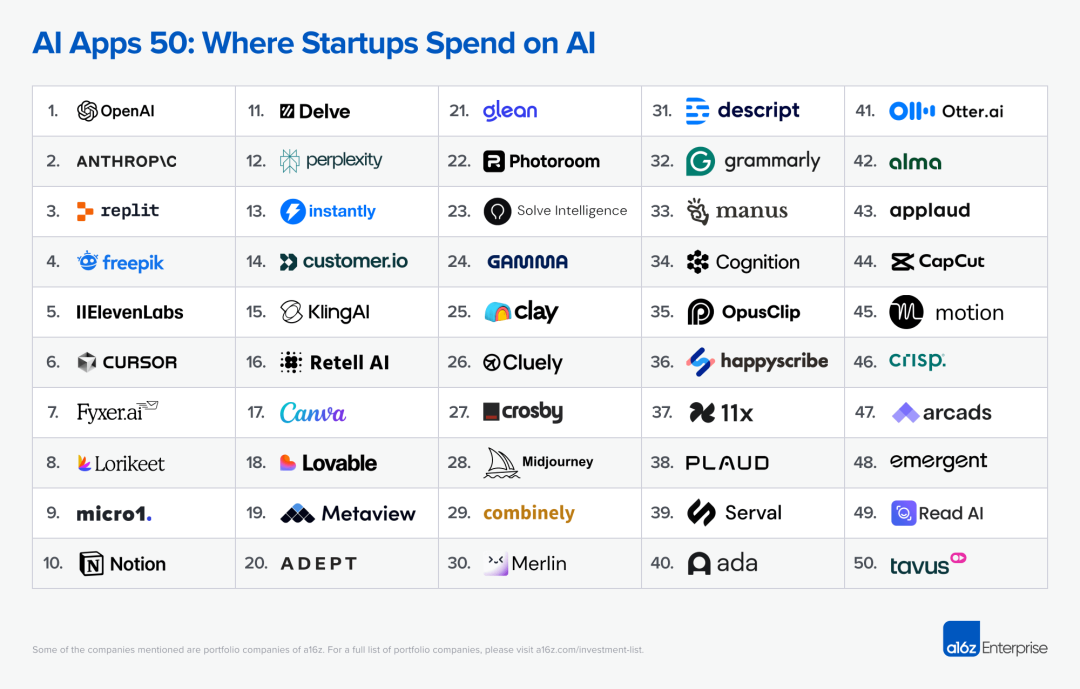Where Are AI-Native Startups Spending Their Money on AI Products?

The Shift from Consumer → Professional Users → Enterprise


AI is reshaping skills, tasks, and team structures — and the impact differs sharply between large corporations and startups.
- Large enterprises: Incremental efficiency gains within existing workflows.
- Startups: Birth of truly AI-native companies built on next-generation software.
---
What Defines This New Generation of Software?
Recently, a16z partnered with Mercury to analyze real financial spending data (June–August 2025) from Mercury’s 200,000+ startup customers.
The goal: Identify the Top 50 AI application-layer companies, ranked not by web visits, but by actual cash flow.
> Mercury is a fintech provider of startup-focused banking, credit cards, and financial tools.
Why this matters:
- Compute infra vendors reveal what startups are building.
- This list reveals how AI is actually deployed in products and workflows, and where early-stage companies are willing to pay.
- Patterns match survey data: AI budgets are rising, with higher ROI than traditional tools.
Categories represented:
- Vibe Coding platforms
- Creative tools
- Customer service solutions
This supports a core AI thesis: AI expands niche expertise into company-wide capabilities — today, everyone can be a creator.
---
📊 The "Top 50 AI Applications" List

Exclusions:
- Cloud service resellers (Azure, etc.)
- GPU providers (Coreweave, etc.)
- Infrastructure tools
- (Google Cloud + Gemini spending combined due to inseparable data)
Data scope:
- Transactions via Mercury: ACH, wire transfers, and IO card spending.
- Excludes non-Mercury card use and personal accounts.
---
Key Observations
1️⃣ Horizontal Applications Dominate (60%)
Horizontal = usable by anyone, across roles. Vertical = specific professional niches.
Top horizontal category:
- General-purpose LLM assistants:
- OpenAI (#1)
- Anthropic (#2)
- Perplexity (#12)
- Merlin AI (#30)
Document-centric LLM platforms:
- Notion (#10)
- Manus (#33)
Why market is unsettled:
- No clear single leader yet.
- Likely multi-interface / multi-model usage depending on task.
---
Other horizontal strongholds:
Meeting support tools (transcription + productivity):
- Fyxer (#7)
- Happyscribe (#36)
- Plaude (#38)
- Otter AI (#41)
- Read AI (#49)
- Cluely (#26, real-time feedback)
Creative tools: Now cross-functional — marketing, design, product teams all use them.
Vibe Coding: AI app creation for engineers & non-engineers, now reaching enterprise scale.
---
💡 Platform Highlight:
AiToEarn — an open-source global AI content monetization platform enabling:
- AI content creation
- Cross-platform publishing (Douyin, Kwai, WeChat, Bilibili, Xiaohongshu, FB, IG, LinkedIn, Threads, YouTube, Pinterest, X/Twitter)
- Analytics
- AI model rankings (View rankings)
Docs: AiToEarn Documentation
---
2️⃣ Creative Tools: Largest Single Category (10/50)
Leaders:
- Freepik (#4, all-in-one suite)
- ElevenLabs (#5, text-to-speech)
Image tools: Canva, Photoroom, Midjourney
Video tools: Descript, Opus Clip, Capcut
Emerging avatar tools: Arcads (#47), Tavus (#50)
---
3️⃣ Vertical Applications: Augment vs Replace Humans
Two pathways:
- Augment – AI removes repetition, humans focus on value-add
- Replace – AI acts as full-time “employee”
Current status:
- 12 augment-focused
- 5 “AI employee” models:
- Crosby Legal (#27)
- Cognition (#34)
- 11x (#37)
- Serval (#39)
- Alma (#42)
Vertical categories:
- Customer Service: Lorikeet (#8), Customer.io (#14), Ada (#40), Crisp (#46)
- Sales / GTM: Instantly (#13), Clay (#25), 11x (#37)
- Recruitment / HR: Micro1 (#9), Metaview (#19), Applaud (#43)
- Ops / Compliance: Delve (#11), Combinely (#29)
---
4️⃣ Vibe Coding Moves Into Enterprise
Companies: Replit, Cursor, Lovable, Emergent
Revenue contrast:
- Replit (#3): Enterprise-grade autonomous agents + full dev stack (DB, auth, secure publishing, enterprise controls)
- Lovable: Fast UI generation, consumer-friendly focus → lower revenue in B2B
Implication: Enterprise buyers value end-to-end capabilities + control.
---
5️⃣ Product Migration: Consumer → Enterprise
Nearly 70% of ranked companies start with individual adoption, then expand to teams.
Examples:
- Cluely (#26)
- Midjourney (#28)
For model providers:
- OpenAI shifted in one year from 75% consumer revenue to ~50/50 split.
Impact:
Enterprise adoption cycles now take 1–2 years, not decades.
---

---
🚀 Strategic Takeaway
Consumer-grade AI is already enterprise-capable.
Platforms like AiToEarn官网 unify creation → publishing → monetization for both personal and corporate users, bridging gaps between consumer enthusiasm and enterprise-scale execution.
Supported platforms: Douyin, Kwai, WeChat, Bilibili, Xiaohongshu, Facebook, Instagram, LinkedIn, Threads, YouTube, Pinterest, X (Twitter).



---
❤️ Click “Heart” before you go.
---
Final Note
In the age of AI-driven creativity, ecosystems like AiToEarn shorten the path from idea → audience → revenue by integrating:
- AI content generation tools
- Multi-platform publishing pipelines
- Analytics
- Model ranking (View rankings)
---
Would you like me to also create an executive summary table comparing Horizontal vs Vertical market segments for faster reading? That could make this research more actionable.

